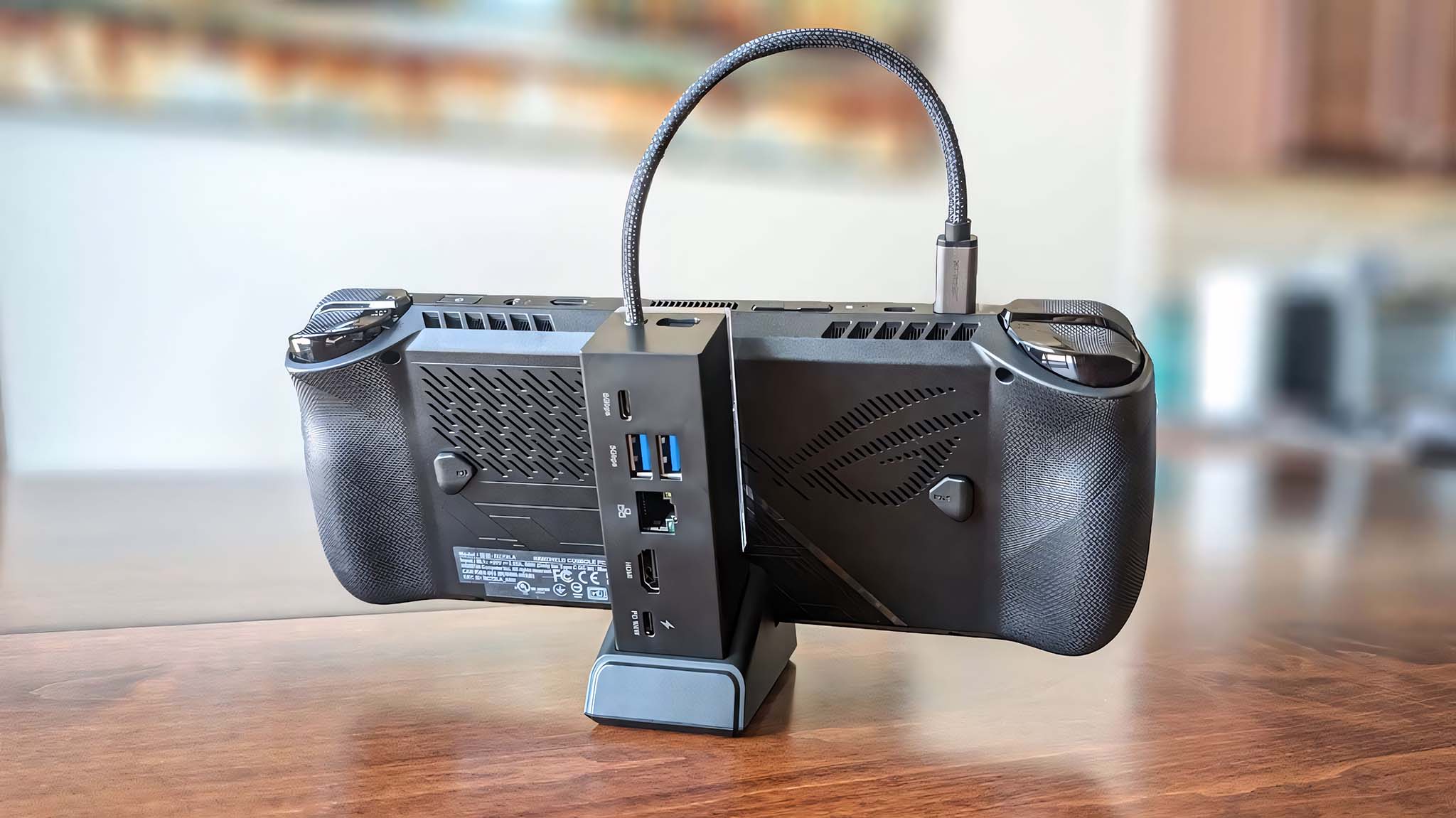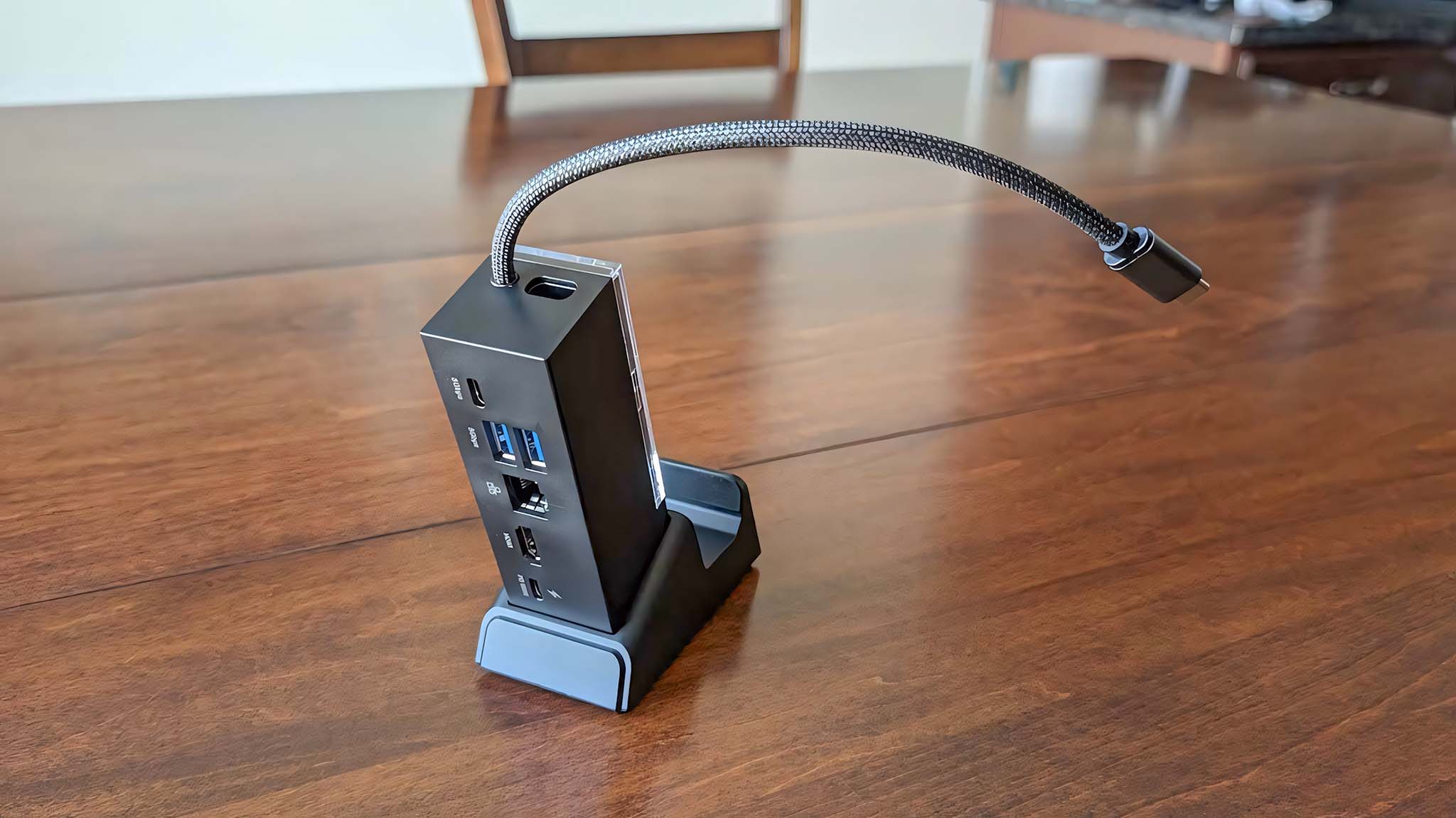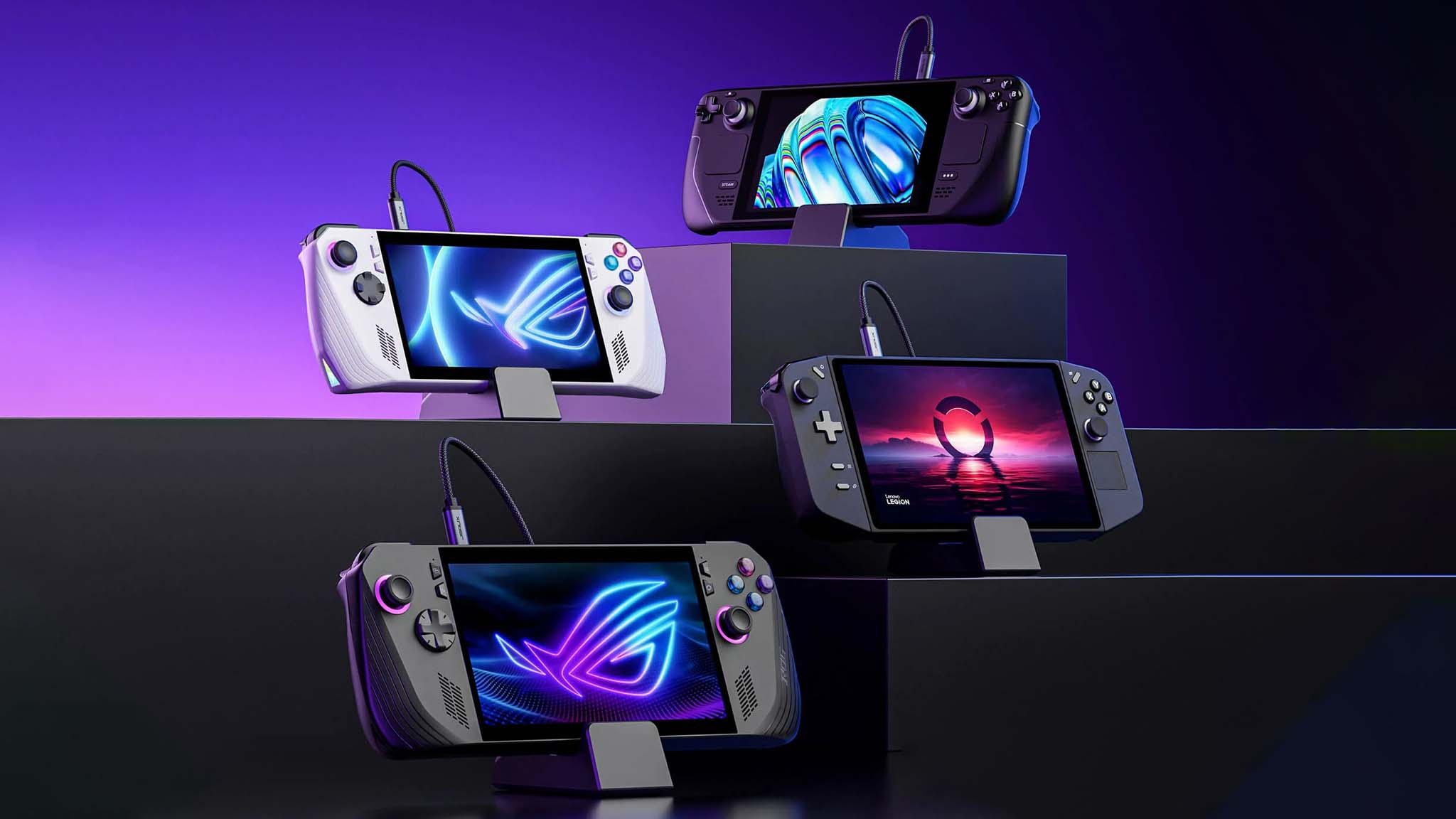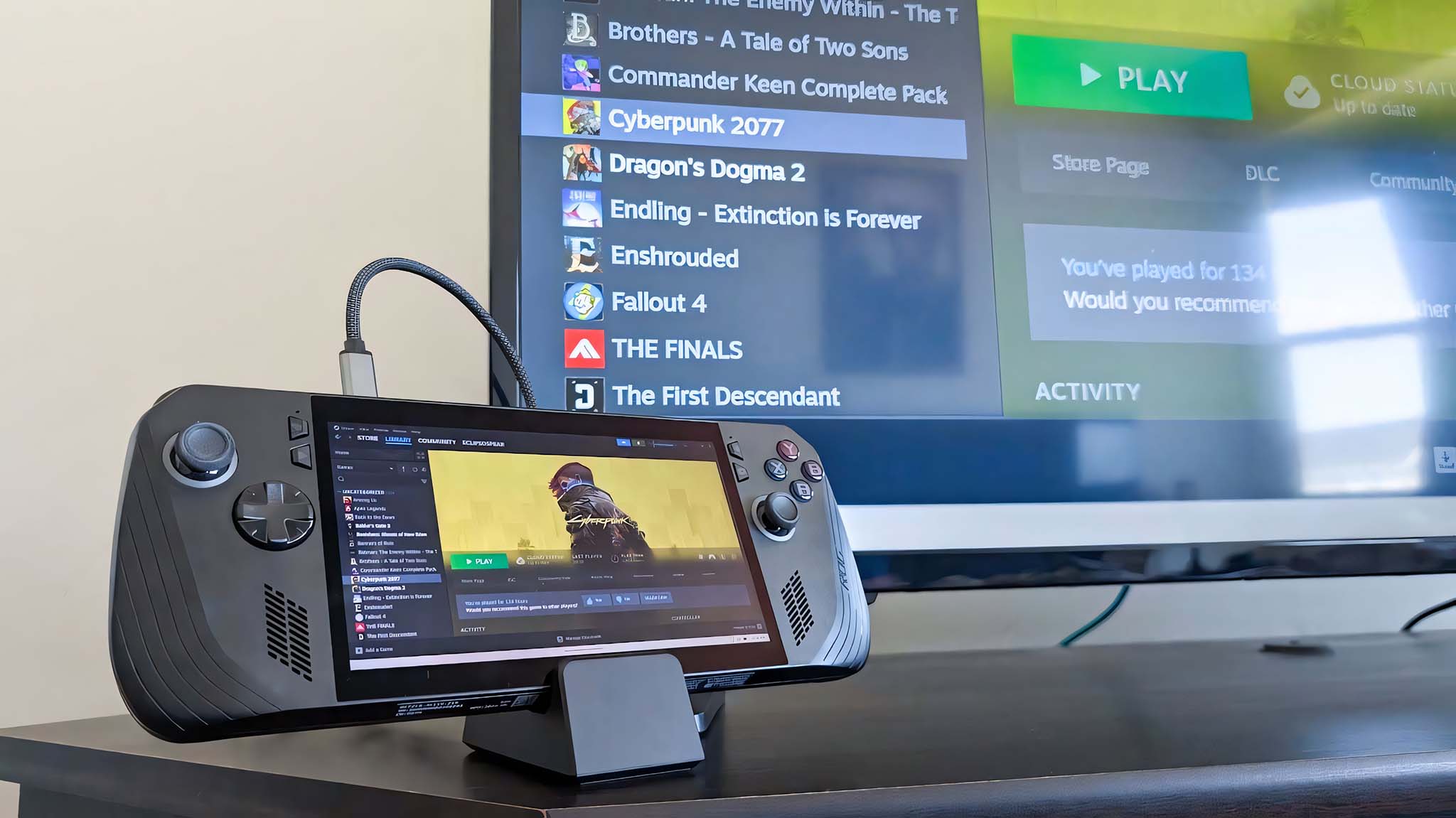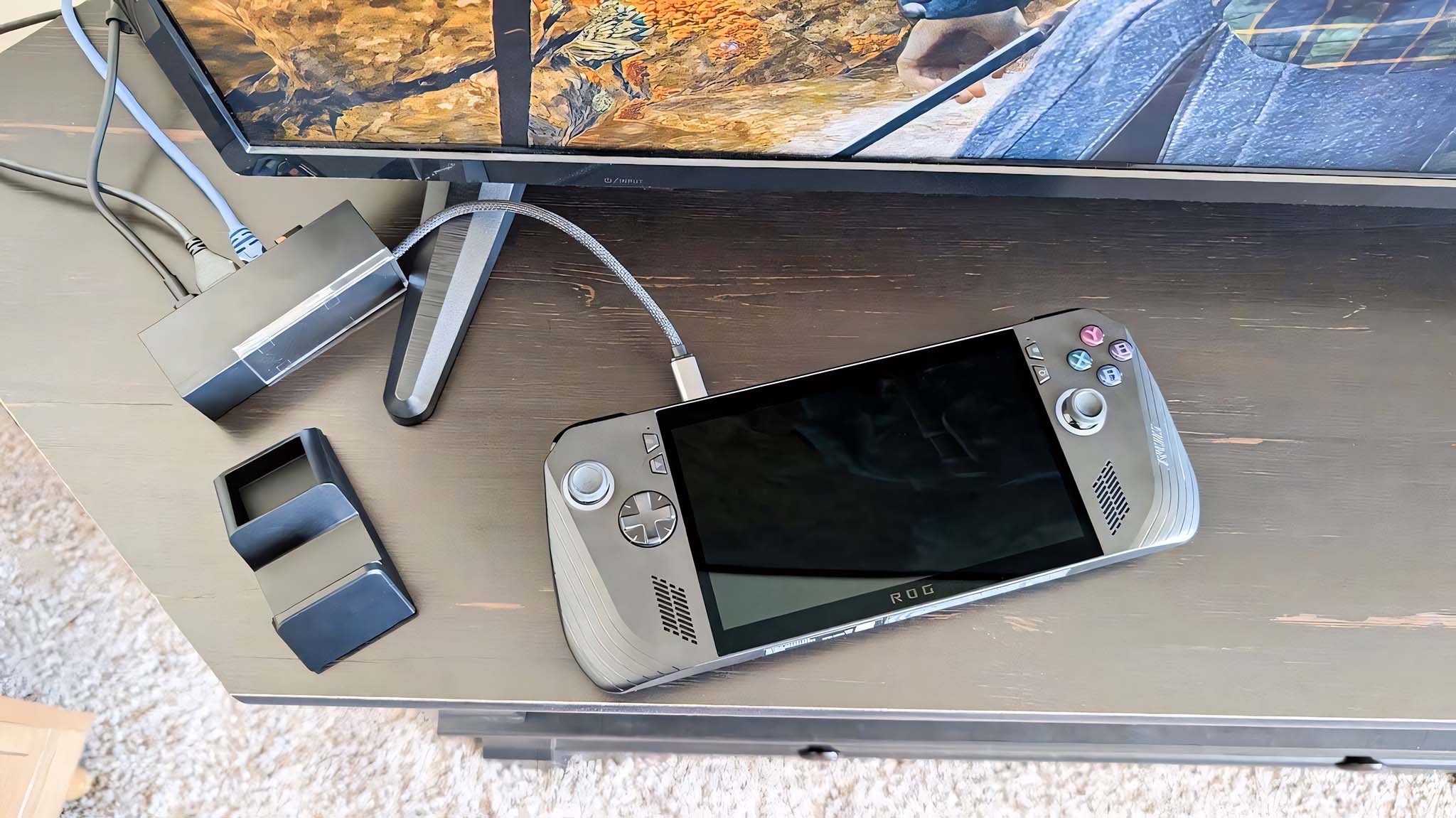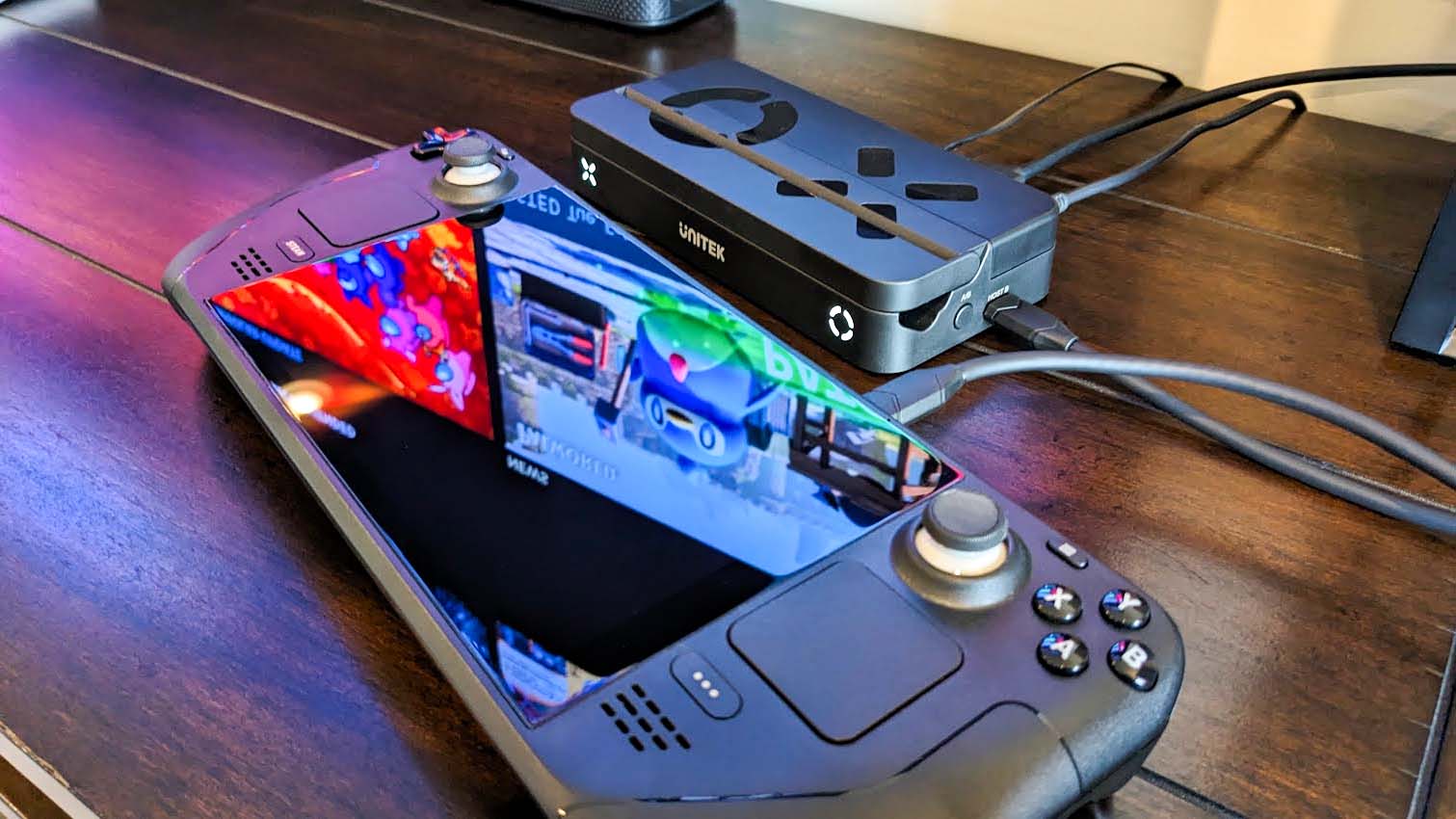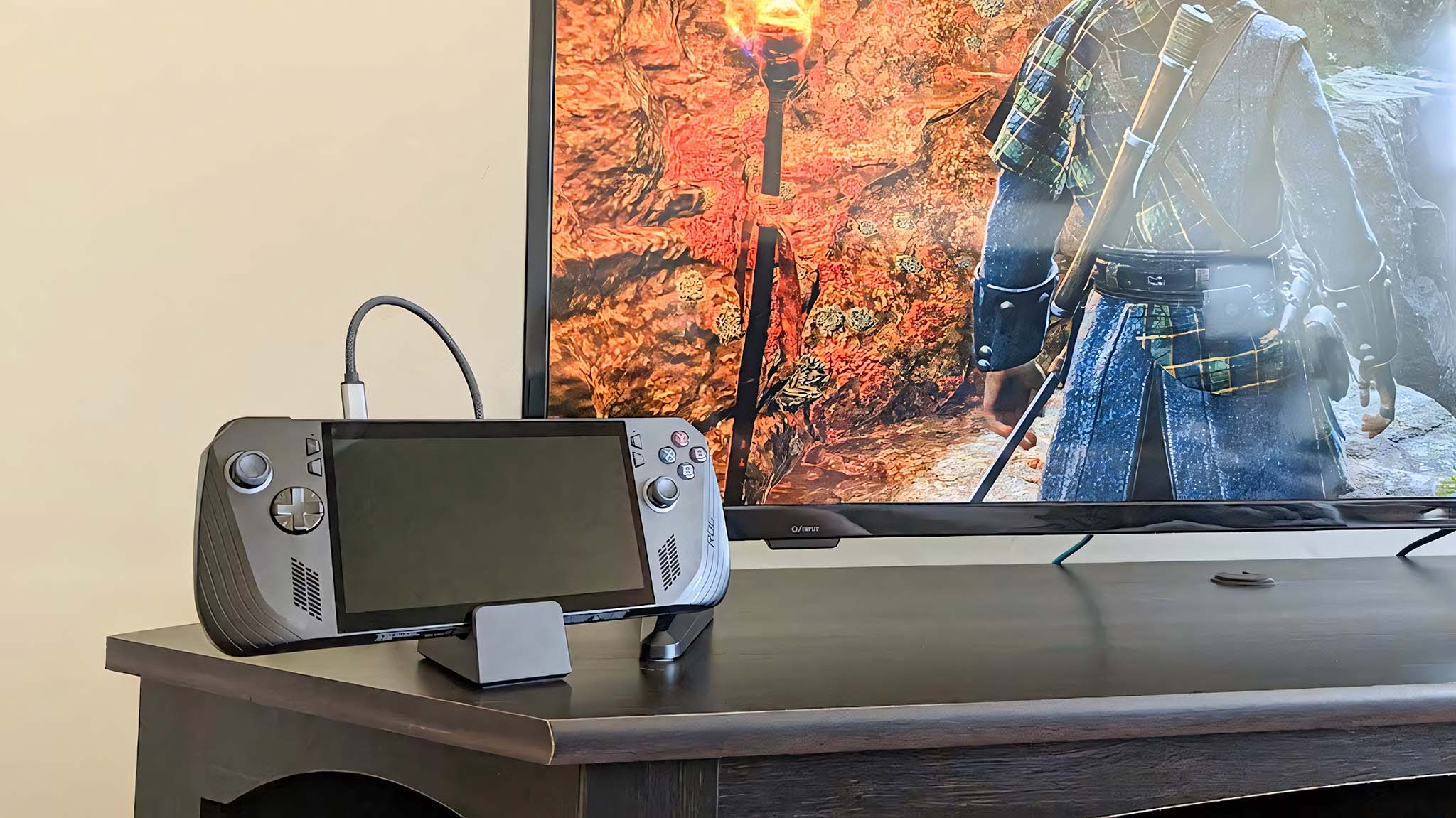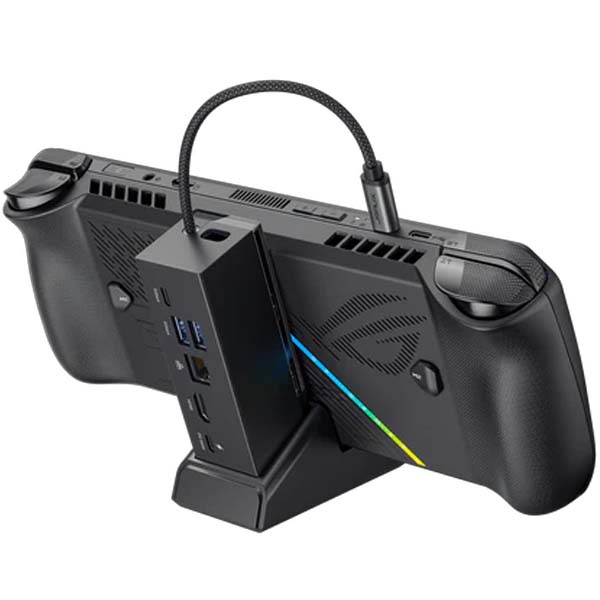Windows Central Verdict
Thanks to the placement of the USB-C cable, this JSAUX 6-in-1 Multifunctional Docking Station easily fits the ROG Ally X and Legion Go ports without straining, which is a problem many other docking stations have. With PD 100W power flow and video output up to 4K at 120Hz or 1080p at 240Hz, your gaming handhelds will charge up while being used and will look good on a TV or gaming monitor, too. It's easy to set up, but you'll need to supply your own HDMI 2.1 cable and hold your handheld steady, since the narrow docking station base isn't the sturdiest thing.
Pros
- +
Compatible with all mainline PC gaming handhelds
- +
Has a long enough USB-C cable to fit ROG Ally X
- +
Plenty of ports for connecting accessories
- +
Doesn't take up a lot of space
- +
Versatile design for upright or flat connection
- +
HDMI 2.1 supports 4K at 120Hz or 1080p at 240Hz
Cons
- -
Not as sturdy as other docking stations
- -
No HDMI cable included
Why you can trust Windows Central
While doing my ROG Ally X review, I discovered that many docking stations currently on the market do not work with this newer gaming handheld. It's not a matter of power, since the Ally X has the same 65W power flow requirements as the original Ally. Rather, many handheld docking stations don't have a long enough USB-C cable to plug into the Ally X's ports while the device is being propped up. Obviously, you don't want to strain the cable, as this can damage the docking station or your expensive handheld.
That's why I instantly became interested when I learned that the well-known gaming accessory company, JSAUX, had released a brand-new docking station specifically designed to fit the Ally X. I've been using this 6-in-1 Multifunctional Docking Station HB0609 for a few days with my Ally X, original ROG Ally, Steam Deck, and Legion Go gaming handhelds to see how well it works. Here's what I've discovered.
This review was made possible with a review sample provided by JSAUX. The company did not see the contents of the review before publishing.
JSAUX 6-in-1 Multifunctional Docking Station: Price and availability
MSRP Price: $45.99
Resolution: Up to 4K at 120Hz or 1080p at 240Hz
Compatibility: ROG Ally X, ROG Ally, Steam Deck, Legion Go, MSI Claw
Input power: PD 100W
Cable length: 18cm (7 inches)
Ethernet: 1000MBps Gigabit
Ports: 1x USB-C 3.2 Gen 1 port, 1x USB-C PD 100W port, 2x USB-A 3.2 Gen 1 ports, 1x Ethernet port, and 1x HDMI 2.1 port
Dimensions: 120 x 85 x 45mm (4.72 x 3.35 x 1.77 inches)
Weight: ~179g (6.31 oz)
JSAUX's HB0609 docking station has an MSRP of $45.99, which is somewhat expensive but within a range that we'd expect from this sort of ROG Ally and ROG Ally X accessory. It costs more than some others because it has an HDMI 2.1 port rather than the older HDMI 2.0 port. It also has plenty of ports for accessories, and the input USB-C port is 100W, which is higher than many competitors.
In other words, you could definitely go with more affordable docking stations on the market, but this one is powerful enough to work with all modern PC gaming handhelds rather than just the lower-power Steam Deck. You'll be able to get better resolution and refresh rates while being sure that your handheld is charging back up while you use it.
As I previously mentioned, the dock's cable easily plugs into the Ally X port without any damaging straining. This also means that it can more easily plug into the Legion Go, which is taller than many other handhelds and thus has a similar problem where many docking station USB-C cables cannot plug into it.
At the time of writing, the JSAUX 6-in-1 Multifunctional Docking Station HB0609 is only available for purchase at the JSAUX website. However, the company often brings its products to Amazon, so you might find it selling there eventually.
JSAUX 6-in-1 Multifunctional Docking Station HB0609 | $45.99 at JSAUX
This docking station is specifically designed with a long enough USB-C cable to plug into ROG Ally X, the original ROG Ally, Steam Deck, and Legion Go. It features a USB-C 3.2 Gen 1 port, a USB-C PD 100W port, two USB-A 3.2 Gen 1 ports, an Ethernet port, and an HDMI 2.1 port.
JSAUX 6-in-1 Multifunctional Docking Station: What's good
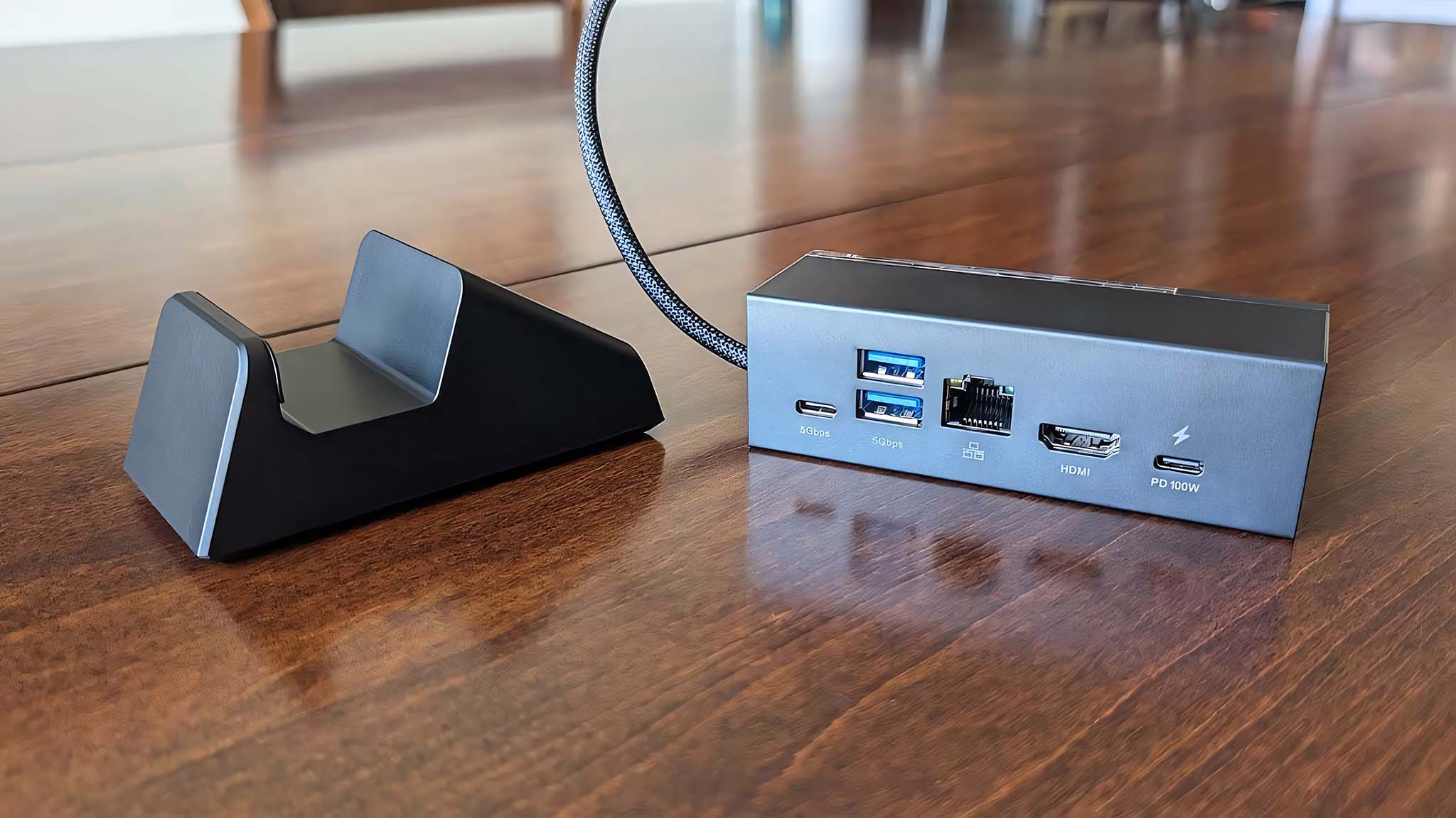
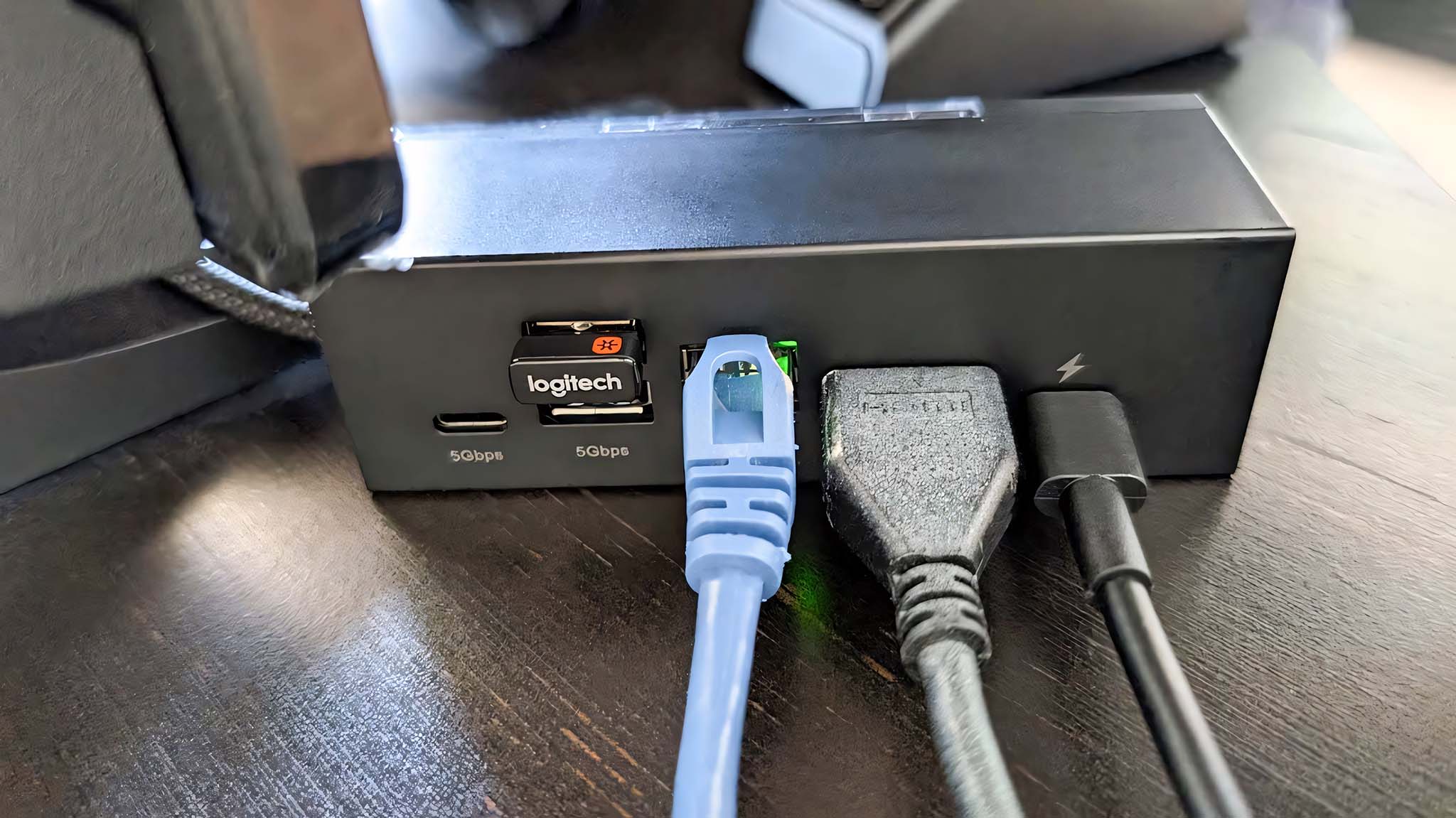

After opening the package, I was surprised to find that this docking station is actually made up of two parts — a stand and the actual port hub that doubles as a means to prop your gaming handheld up. This design makes the HB0609 a more versatile accessory since I can either use it like a standard handheld docking station that can prop up my Ally X or else I can lay my handheld flat beside it. If I was to travel with it, I'd probably only take the hub part since it would be easier to stick into a bag.
All the latest news, reviews, and guides for Windows and Xbox diehards.
Overall, this device has a good amount of ports to meet my various accessory and connecting needs. In total, there are two USB-A 3.2 Gen 1 ports and a USB-C 3.2 Gen 1 port. I used these to connect my wireless keyboard, mouse, and gaming headset. The other USB-C port is simply a power port, and you'll want to plug your gaming handheld's power cable into this in order to charge your device. Outside of that, there is an RJ45 port for wired internet and an HDMI 2.1 port, which supports up to 4K at 120Hz or 1080p at 240Hz. In case you're wondering, the ROG Ally and Ally X display reaches up to 120Hz, while the Legion Go's display reaches up to 144Hz.
If you've looked through my pictures, you'll notice that there appears to be a USB-C port near where the USB-C cable comes out. However, this does not supply any power. It's merely a place to plug the cable into for tidier storage.
You might have noticed that there is a clear plastic covering on the front of the docking station. This design choice confused me at first, and it wasn't until JSAUX explained it to me that I understood what it was trying to do. Apparently, JSAUX says this plastic is called a Swap Sheet, and it's meant to be removed so you can place stickers and other design elements under it. Additionally, JSAUX has provided HB0609 docking station 3D models at Printables so that people with 3D printers can design and print their own customized Swap Sheet and/or Base Stand if they want.
Honestly, this is a very niche nicety that many people won't use. That said, if you happen to be one of the few gaming handheld owners who also has a 3D printer and feels inclined to print a customized dock, have at it.
In case you were wondering, this docking station works with all mainline PC gaming handhelds, including Steam Deck, Legion Go, original Ally, and the Ally X. I even tested each of these devices with the dock to make sure they worked well. As I said earlier, it's just especially marketed toward the Ally X because it's one of the few docking stations guaranteed to have a cable that can fit into the new gaming system's port without straining.
Setting up this JSAUX docking station was incredibly easy. I simply placed the hub into its stand, plugged the necessary cables between it and my TV, plugged the Ally X power cable into it, and finally placed my Ally X into the base and then plugged the USB-C cable into one of the two Ally X ports. The handheld gives a visual and audible queue, letting you know it detected the connection, and then displays its signal on the TV or monitor that the dock is connected to.
🔥The hottest trending deals🔥
- Seagate Xbox Series X|S Expansion Card (2TB) | was
$359.99now $249.99 at Best Buy - Xbox Game Pass Ultimate (3-months) | was
$49.99now $31.99 at CDKeys - Alienware 34 Curved QD-OLED Gaming Monitor | was
$899.99now $699.99 at Dell - HP Victus 15.6 Gaming Laptop (Ryzen 5, RTX 4050) | was
$979now $599 at Walmart - Amazon Fire TV Stick 4K Max + Xbox Wireless Controller + Xbox Game Pass Ultimate (1-month) | was
$119.98now $82.85 at Amazon - Logitech G502 LIGHTSPEED Wireless Gaming Mouse | was
$149.99now $89.65 at Amazon - Samsung Class QE1C QLED TV (85-inch) | was
$2,799.99now $1,229.99 at Samsung - Razer DeathAdder V3 Wired Gaming Mouse | was
$69.99now $50.99 at Best Buy - Surface Laptop Go 3 (Core i5) | was
$799.99now $599.99 at Best Buy - Razer Basilisk V3 Wired Gaming Mouse | was
$69.99now $49.99 at Best Buy
By default, the Ally X display mirrors itself onto my TV, so I did have to go into the handheld's Windows display settings and change it so it displayed to "Second screen only." With this done, the Ally X's display went black, and I could focus on my TV without worrying about wasting energy. In case you're wondering, I use an Xbox Series X controller when playing my gaming handhelds in docked mode. It's a simple matter of connecting the gamepad to the handheld via Windows Bluetooth settings, and then the two devices are paired and ready for gaming. This is my gamepad of choice, since many PC games are designed specifically to work with this controller.
If you need help with this connecting process, check out our guide on how to use an Xbox controller with your PC. The steps listed in the guide are the same on ROG Ally and Legion Go, since they run Windows 11 as their operating system.
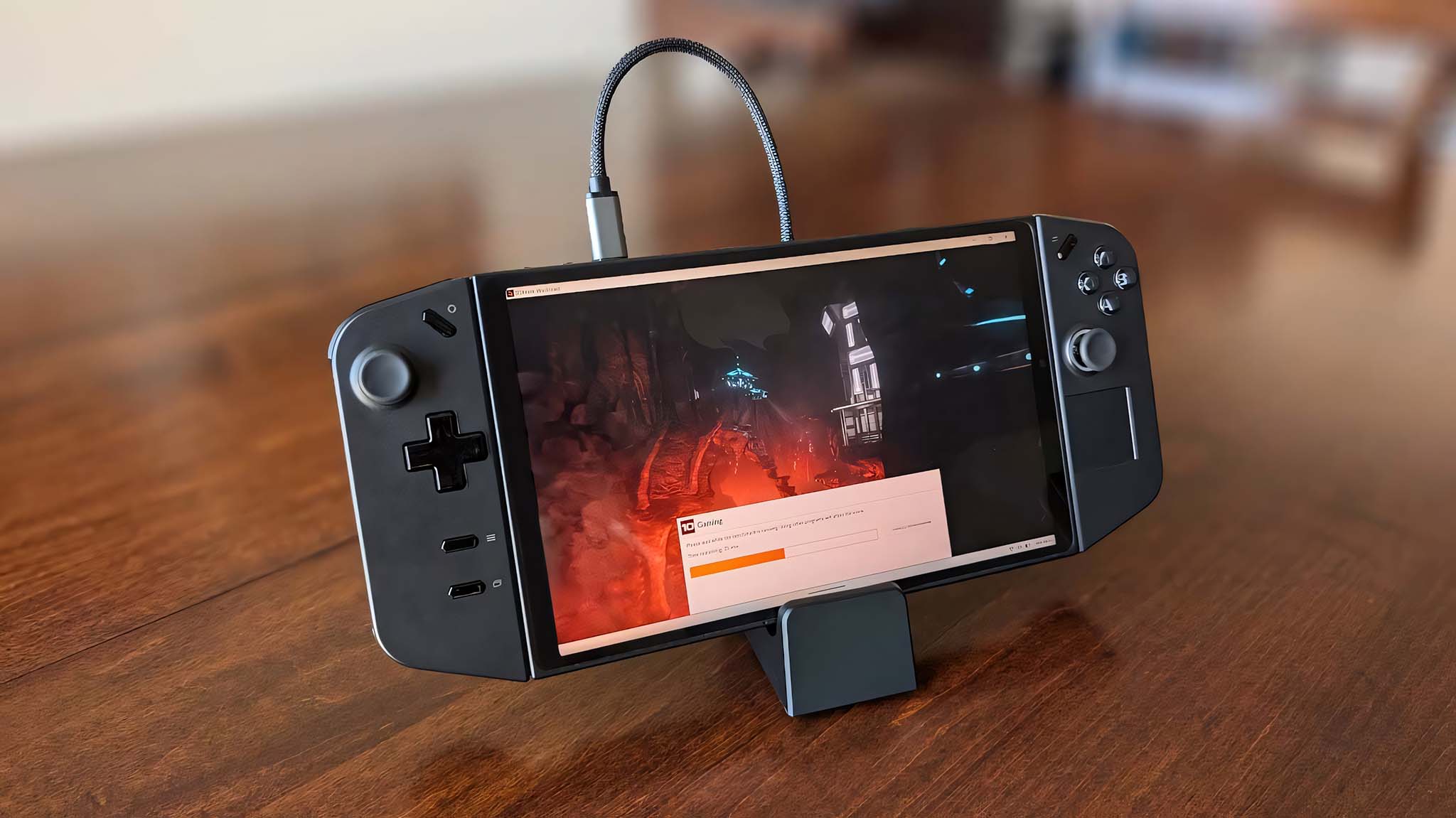

After getting the docking station set up, it didn't take long for me to realize that my games were experiencing a lot of screen tearing on the TV, which was strange because I don't see this when playing the Ally X in handheld mode. However, this turned out to be my own user error. You see, I had accidentally plugged the HDMI 2.1 cable into a TV port that didn't support HDMI 2.1. Once I swapped TV ports to a compatible one, my games played very smoothly and with good motion clarity.
To double-check the dock's performance, I also connected it to my Alienware AW2725DF gaming monitor which has an HDMI 2.1 port (as seen in my Alienware AW2725DF review) and then played a few games from my ROG Ally X, Legion Go, and Steam Deck on it. Once again, motion clarity was very good and my games were very enjoyable to play.
JSAUX 6-in-1 Multifunctional Docking Station: What's bad
My biggest problem with the 6-in-1 Multifunctional Docking Station is that it's not the sturdiest thing. The base is so narrow that when I plug the USB-C into the ROG Ally X's port, I have to steady the handheld, or else it will teeter over. What's more, the actual hub with the ports wobbles a bit in its stand. I've never had an issue with the handheld falling out or the docking station coming apart, but it's not as steady as I'd prefer.
Additionally, since this docking station doesn't come with an HDMI cable, you'll need to supply one yourself. For the best experience, you'll want to make sure you get a 2.1 cable and that you're plugging it into a TV or monitor that also supports HDMI 2.1. If you need help with that, check out our list of the best HDMI cables, as well as, our list of the best gaming monitors and best gaming TVs.
JSAUX 6-in-1 Multifunctional Docking Station: Competition
There are tons of gaming handheld docking stations on the market right now. The problem is, you need to make sure that the one you buy is compatible with your device. This means making sure the dock supplies the right amount of power to charge up your handheld while you use it, and also getting a dock that supports the right resolution and refresh rate to meet your desires. For instance, Steam Deck only needs a 45W power flow. However, Legion Go, Ally, and Ally X all need a 65W power flow.

• Best power banks for ROG Ally
• Best microSD cards for ROG Ally
• Best ROG Ally accessories
• Best ROG Ally carrying cases
• Best ROG Ally games
• Best gaming handhelds
Those of you who have a Steam Deck or original ROG Ally will find that the JSAUX Steam Deck Dock is a fantastic choice. As seen in our JSAUX Steam Deck Dock review, this accessory has six connections but is available at a much more affordable price than the ROG Ally X-specific one. That said, it only has an HDMI 2.0 port rather than an HDMI 2.1, but you don't need the latter if you have a Steam Deck. It sells for $33.99 at Amazon.
Alternatively, I own the Syntech 6-in-1 Docking Station and regularly use it with my original ROG Ally and Steam Deck. The cable isn't long enough to reach my ROG Ally X port, though. Still, as seen in our Syntech 6-in-1 Docking Station review, this is a very affordable and useful accessory for some gaming handhelds. It was selling for $38.99 at Amazon at the time of writing.
If you're like me and own different types of gaming handhelds, then you should take a look at my Unitek TV Dock for Nintendo Switch and Steam Deck review. This unique accessory can be used to dock the Switch or else can be connected to other gaming handhelds via a long USB-C cable. Because of this, the cable has no issues reaching the ROG Ally X. Simply push the toggle button on the side to determine whether power goes to the Switch docking area or the USB-C cable. However, it only has an HDMI 2.0 port, so you can't get the best resolution or refresh rate out of your Legion Go or Ally devices. Still, it's a nice option if you don't care about having the best resolution, and it features three USB-A 3.0 ports to connect other accessories. Right now, it's available for $47.99 at Amazon.
JSAUX 6-in-1 Multifunctional Docking Station: Should I buy it?
✅ You should buy it if...
- You have a Windows 11 gaming handheld: ROG Ally, ROG Ally X, MSI Claw, and Legion Go are all powerful Windows 11 gaming handhelds that require more power to run than Steam Deck does. They also support higher resolution and refresh rate output, so you optimally want a dock that can keep up with their features. For instance, supporting 4K at 120Hz or 1080p at 240Hz.
- You want a docking station that's compatible with ROG Ally X: Many docking stations on the market don't have a USB-C cable that can reach the newer ROG Ally X's ports. This one has plenty of cable room and doesn't strain at all.
- You'd like a versatile docking station that's easy to travel with: Because of the two-part design, you can either have this docking station prop up your gaming handheld or else lie it flat next to your device. If you travel, you might find leaving the base behind and only taking the hub is a more convenient choice.
❌ You should not buy it if...
- You'd prefer a sturdier gaming dock: The JSAUX 6-in-1 Multifunctional Docking Station HB0609 won't just fall over while you're using it, but its versatile, two-part design and narrow base make it a bit more wobbly than some other options.
- You want something that comes in another color: At the moment, this docking station is only available in black. It's a good color overall for accessories, unless it somehow clashes with your preferences.
If you have an ROG Ally, ROG Ally X, or Legion Go, then you should definitely consider this docking station. It offers the right amount of power to sustain Windows 11 PC gaming handhelds while outputting higher resolution and refresh rates than other docking stations out there. What's more, thanks to the location of the USB-C cable, this is one of the few docking stations that can reach the ROG Ally X's ports. You'll want to steady your device while plugging the USB-C into it, since the docking station's base is too narrow to do this itself.
However, if you have a Steam Deck, you don't need this much power or this kind of video output and can find something cheaper to meet your needs. If you want to get the best visual experience from this dock, just make sure you supply an HDMI 2.1 port and connect this accessory to a compatible HDMI 2.1 monitor or TV. When everything is connected, the JSAUX 6-in-1 Multifunctional Docking Station HB0609 provides a very good playing experience, overall.

Self-professed gaming geek Rebecca Spear is one of Windows Central's editors and reviewers with a focus on gaming handhelds, mini PCs, PC gaming, and laptops. When she isn't checking out the latest games on Xbox Game Pass, PC, ROG Ally, or Steam Deck; she can be found digital drawing with a Wacom tablet. She's written thousands of articles with everything from editorials, reviews, previews, features, previews, and hardware reviews over the last few years. If you need information about anything gaming-related, her articles can help you out. She also loves testing game accessories and any new tech on the market. You can follow her @rrspear on X (formerly Twitter).
